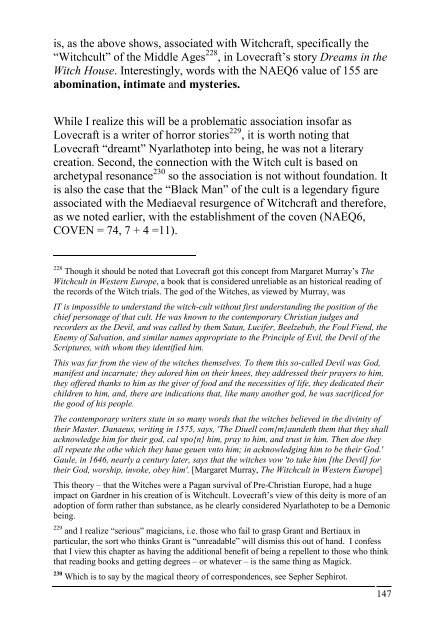Anthony Testa - The Key of the Abyss.pdf
Anthony Testa - The Key of the Abyss.pdf
Anthony Testa - The Key of the Abyss.pdf
Create successful ePaper yourself
Turn your PDF publications into a flip-book with our unique Google optimized e-Paper software.
is, as <strong>the</strong> above shows, associated with Witchcraft, specifically <strong>the</strong><br />
“Witchcult” <strong>of</strong> <strong>the</strong> Middle Ages 228 , in Lovecraft’s story Dreams in <strong>the</strong><br />
Witch House. Interestingly, words with <strong>the</strong> NAEQ6 value <strong>of</strong> 155 are<br />
abomination, intimate and mysteries.<br />
While I realize this will be a problematic association ins<strong>of</strong>ar as<br />
Lovecraft is a writer <strong>of</strong> horror stories 229 , it is worth noting that<br />
Lovecraft “dreamt” Nyarlathotep into being, he was not a literary<br />
creation. Second, <strong>the</strong> connection with <strong>the</strong> Witch cult is based on<br />
archetypal resonance 230 so <strong>the</strong> association is not without foundation. It<br />
is also <strong>the</strong> case that <strong>the</strong> “Black Man” <strong>of</strong> <strong>the</strong> cult is a legendary figure<br />
associated with <strong>the</strong> Mediaeval resurgence <strong>of</strong> Witchcraft and <strong>the</strong>refore,<br />
as we noted earlier, with <strong>the</strong> establishment <strong>of</strong> <strong>the</strong> coven (NAEQ6,<br />
COVEN = 74, 7 + 4 =11).<br />
228<br />
Though it should be noted that Lovecraft got this concept from Margaret Murray’s <strong>The</strong><br />
Witchcult in Western Europe, a book that is considered unreliable as an historical reading <strong>of</strong><br />
<strong>the</strong> records <strong>of</strong> <strong>the</strong> Witch trials. <strong>The</strong> god <strong>of</strong> <strong>the</strong> Witches, as viewed by Murray, was<br />
IT is impossible to understand <strong>the</strong> witch-cult without first understanding <strong>the</strong> position <strong>of</strong> <strong>the</strong><br />
chief personage <strong>of</strong> that cult. He was known to <strong>the</strong> contemporary Christian judges and<br />
recorders as <strong>the</strong> Devil, and was called by <strong>the</strong>m Satan, Lucifer, Beelzebub, <strong>the</strong> Foul Fiend, <strong>the</strong><br />
Enemy <strong>of</strong> Salvation, and similar names appropriate to <strong>the</strong> Principle <strong>of</strong> Evil, <strong>the</strong> Devil <strong>of</strong> <strong>the</strong><br />
Scriptures, with whom <strong>the</strong>y identified him.<br />
This was far from <strong>the</strong> view <strong>of</strong> <strong>the</strong> witches <strong>the</strong>mselves. To <strong>the</strong>m this so-called Devil was God,<br />
manifest and incarnate; <strong>the</strong>y adored him on <strong>the</strong>ir knees, <strong>the</strong>y addressed <strong>the</strong>ir prayers to him,<br />
<strong>the</strong>y <strong>of</strong>fered thanks to him as <strong>the</strong> giver <strong>of</strong> food and <strong>the</strong> necessities <strong>of</strong> life, <strong>the</strong>y dedicated <strong>the</strong>ir<br />
children to him, and, <strong>the</strong>re are indications that, like many ano<strong>the</strong>r god, he was sacrificed for<br />
<strong>the</strong> good <strong>of</strong> his people.<br />
<strong>The</strong> contemporary writers state in so many words that <strong>the</strong> witches believed in <strong>the</strong> divinity <strong>of</strong><br />
<strong>the</strong>ir Master. Danaeus, writing in 1575, says, '<strong>The</strong> Diuell com{m}aundeth <strong>the</strong>m that <strong>the</strong>y shall<br />
acknowledge him for <strong>the</strong>ir god, cal vpo{n} him, pray to him, and trust in him. <strong>The</strong>n doe <strong>the</strong>y<br />
all repeate <strong>the</strong> o<strong>the</strong> which <strong>the</strong>y haue geuen vnto him; in acknowledging him to be <strong>the</strong>ir God.'<br />
Gaule, in 1646, nearly a century later, says that <strong>the</strong> witches vow 'to take him [<strong>the</strong> Devil] for<br />
<strong>the</strong>ir God, worship, invoke, obey him'. [Margaret Murray, <strong>The</strong> Witchcult in Western Europe]<br />
This <strong>the</strong>ory – that <strong>the</strong> Witches were a Pagan survival <strong>of</strong> Pre-Christian Europe, had a huge<br />
impact on Gardner in his creation <strong>of</strong> is Witchcult. Lovecraft’s view <strong>of</strong> this deity is more <strong>of</strong> an<br />
adoption <strong>of</strong> form ra<strong>the</strong>r than substance, as he clearly considered Nyarlathotep to be a Demonic<br />
being.<br />
229<br />
and I realize “serious” magicians, i.e. those who fail to grasp Grant and Bertiaux in<br />
particular, <strong>the</strong> sort who thinks Grant is “unreadable” will dismiss this out <strong>of</strong> hand. I confess<br />
that I view this chapter as having <strong>the</strong> additional benefit <strong>of</strong> being a repellent to those who think<br />
that reading books and getting degrees – or whatever – is <strong>the</strong> same thing as Magick.<br />
230<br />
Which is to say by <strong>the</strong> magical <strong>the</strong>ory <strong>of</strong> correspondences, see Sepher Sephirot.<br />
147










